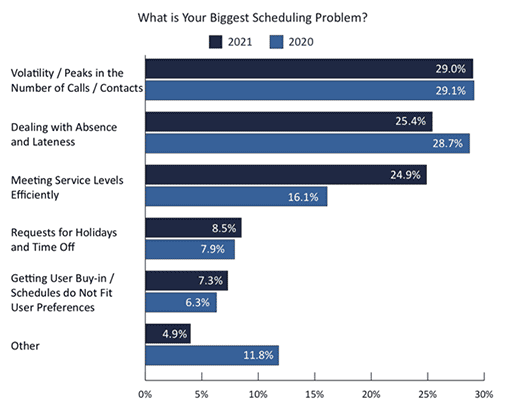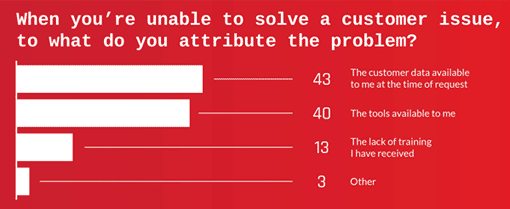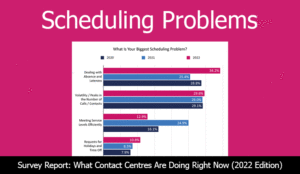Our panel of experts share their thoughts on the most troublesome contact centre problems and how to fix them.
Advisor Enthusiasm
From tight budgets to inefficient processes, several obstacles test contact centre leaders every day. Among all of these difficulties, the most troublesome is agent engagement and general enthusiasm levels.
Why isolate these? Because when advisors are engaged in their work and committed to achieving the best outcomes, everything else falls into place.
At its core, engagement is about creating the right environment for agents to fulfil their potential, give their best each day and have a sense of well-being.
It starts with company culture. Culture and engagement go hand-in-hand. Strive to ensure that advisors feel appreciated, supported and empowered in their roles.

Second, focus on values and seek feedback. Transparency is key here. Ask for help and participation in designing improvement plans. Developing opportunities for advisors to share their thoughts creates connections, ownership, purpose, and belonging.
Third, invest in technology that supports engagement. Equipped with powerful support tools, advisors can resolve problems faster and ensure greater customer satisfaction across all channels.
Contributed by: Jennifer Waite at Playvox
Pushing Efficiency Targets Too Far
Using automation just for efficiency at the sacrifice of customer experience is a real challenge and one we can avoid. Automation definitely has its place within the contact centre. It can make the job easier and bolster advisor satisfaction, as they are not doing repetitive, simple tasks.

However, businesses need to focus on people, not just reducing overheads. After all, most customer experience initiatives turn out to be about driving cost reductions.
The application of chatbots is a great example. It is possible to improve customer journeys with chatbots, but the experience can become limiting and frustrating – especially if contact centres lose sight of critical customer goals. Too often, the focus moves quickly to short-term cost reduction.
Contributed by: Ben Booth at MaxContact
Employee Turnover

Most consumers state that first call resolution (FCR) and engaging with a knowledgeable advisor are two of the most important aspects of good customer service.
However, if contact centres keep re-hiring and training staff, customer service will likely be the first casualty of employee turnover.
To overcome employee turnover, contact centres should consider the following:
- Offering flexible work options: Providing flexibility to advisors regarding their work/life set-up may lead to increased productivity and retention rates.
- Coaching and mentoring strategies: Offering advisors a mentor or team leader coach can be critical to developing long-serving employees. The team will feel valued if someone nurtures their development and success.
- Starting a recognition programme: Rewarding good performance in the form of an extra break, thank you notes or shout-outs on a wallboard will have a warm reception. Having a structured recognition programme that employees get excited about will boost retention.
Contributed by: Neil Draycott at Business Systems
Forecast Volatility/Deviation
Call Centre Helper research found that forecast volatility/deviation, which causes unexpected peaks in demand, is the biggest problem facing schedulers.

Luckily, there are several techniques for reducing such volatility/deviation. For instance, try questioning blips in historical contact volumes, noting down demand drivers, as well as gathering, refining and assessing forecast data.
Often overlooked, one additional example is re-optimizing forecasts. Doing so is critical, yet forecasts are frequently set months in advance and never inspected again. Schedules are allocated, and that is the end of that.
However, periodical re-forecasts and schedule reviews are crucial, as new information may come to light that undermines the accuracy of earlier forecasts.
By running through this process, planners may better align schedules with the latest forecasts. Reallocating advisor activities, reassigning breaks and offering extra shifts will enable them to do so.
Of course, manually, this is time-consuming. However, workforce management (WFM) software automates the process, incorporating the latest contact centre data. The technology also automatically detects trends that impact contact volumes, seasonality and events, helping to reduce volatility further.
High Occupancy Rates = Stressed Agents
Increasing contact volumes, recruitment struggles and high attrition rates make it more difficult for contact centres to meet service level targets. In a desperate attempt to do so, many are pushing occupancy rates higher and higher.
Such a trend is evident in a 2021 Calabrio study, which suggests that: “Agents feel squeezed by more. More calls. More channels. More complexity.”
When making this claim, the report reveals that one in three advisors believe their biggest challenge is handling too many calls. Also, in the last 18 months, 70% of advisors say they manage more calls, while 60% also state that they handle more non-voice interactions.
All of this leads to burnout, which is why many operations cap occupancy at 85%. However, many contact centres overlook this connection and the overarching link between WFM and employee engagement.
Insufficient Data and Technology
A lack of data, inadequate tools and disparate systems are all issues that contact centres continuously grapple with.
Recent Calabrio research confirmed the significance of these problems, asking advisors to reveal the most common blocker that stops them from solving customer queries.
43% of advisors reported that their most significant stumbling block was the available data at the time of the request. A further 40% pinpointed the lack of tools at their disposal.

Of course, implementing new technologies – such as a new CRM, knowledge base and smart desktops – helps to address these issues. However, first, separate the “must-have” features from the “nice to have” features. ROI then becomes much more likely.
Conflicting Business Priorities
Contact centres set metrics that reflect business priorities. These are often grouped into customer, employee and business metrics, ensuring that contact centres give equal attention to each.
Following such a process is great, yet it may illuminate conflicts between measures, which creates problems. Average handling time (AHT) versus quality is a classic example.
Unfortunately, there are many others, including:
- Service level vs. average speed of answer
- Cost per call vs. process improvement
- Service level vs. occupancy

Understanding these conflicts and how metrics are interrelated is the first step forwards. The difficulty is educating stakeholders, who push contact centres to meet impossible goals.
Respond with a wider performance conversation and use dashboards to tell stories. Use reporting tools to provide visuals of metric data and share insights that everyone can understand.
Armed with this evidence, contact centres can confront conflicts and propose new methods of meeting the business strategy.
Contributed by: Charlie Snedden at Calabrio
Recruitment Difficulties

71% of full- and part-time employed workers were either actively looking for a new job or open to new opportunities, according to Reed Global.
The contact centre industry is in the eye of this particular storm. Operations up and down the country are reporting problems with recruiting, with many combating staff shortages by cancelling services and switching to self-service.
The solution? Give job seekers what they desire. That includes the ability to work where they want and when they want.
“Where” they want is increasingly at home, or maybe a mix of home and office. “When” is increasingly not nine-to-five, but a flexible work schedule that fits around their other daily priorities.
Contributed by: Paul Whymark at Sensée
Pins and Passwords Causing Headaches

Traditional authentication tools – such as PINs and passwords – are causing headaches across the industry. Sold on the dark web, they are often exploited for fraudulent activity, costing unfortunate businesses vast sums of money.
Now is the time to confine PINs and passwords to the history books, so modern technologies – such as biometrics – are more widely deployed to safeguard customers.
By layering these solutions into a data protection strategy, contact centres can identify whether someone is who they say they are in less than a second. Such a strategy offers the highest level of security while it also enhances customer experience.
Contributed by: Brett Beranek at Nuance
Contact Centre Connectivity

Many contact centre teams moved from operating in only a handful of locations to supporting an entirely distributed workforce, working from spare rooms or kitchens.
Yet newfound networking challenges have made it difficult for advisors and customers to have comfortable conversations. While the early dramas of a rushed migration have faded, problems persist.
A go-forward model must support consistent quality to ensure a great customer experience. Such an approach will also remove obstacles from advisor performance, keep teams motivated and reduce attrition.
Successful contact centres will address network connection issues. They will look at innovative approaches to quality-of-service management that encompass the employee residential broadband connection.
Contributed by: Mike Palmer at Spearline
Managing the Employee Lifecycle

Advisors have become accustomed to the benefits they have seen from homeworking. Now, with many companies blindly enforcing schedules, such as three days in the office and two at home, many advisors are considering where else offers more time from home.
Such attrition leads to understaffing, causing some companies to return to the compressed opening hours seen at the peak of the COVID-19 pandemic.
Finally, many advisor salaries are now in direct competition with retail, hospitality, and warehouse work. Filling these vacancies is nowhere as easy as it once was.
The current state of events provides no simple solution. Yet having a hybrid working policy – developed through team consultations – will help contact centres avoid getting caught in the eye of this storm.
Contributed by: Dave Vernon at The Forum
Getting Personalization Right

People talk a lot about personalization in customer service, but tangible improvement is rare. For this reason, it continues to be a considerable challenge.
Of course, it sounds like a simple ambition, but enabling personalization across the customer experience is complex to execute and is dependent on up-to-date systems.
So, where to start? Knowing your customers is fundamental. For example, customers often reach out to renew a contracted service in search of a better deal. A simple personalization strategy is to identify these customers, reach out with a proactive message and resecure their business.
In this sense, context is vital. Another example is when routing a return call to the last advisor who spoke to a customer. Doing so creates a better experience for everyone involved.
Contributed by: Neil Titcomb at Odigo
Bridging Skill Gaps

Customers want to speak to someone who knows what they are talking about, who will answer their query honestly, directly and accurately. However, high advisor attrition makes this more difficult.
Becoming knowledgeable and confident in any given field requires training and practice. These things take time. If advisors are coming into and then leaving the business quickly, then the majority of the workforce is unlikely to have a high skill set.
In terms of addressing the issue, there are a variety of micro and macro-economic factors that cause high staff turnover in contact centres. It often proves difficult to identify an immediate solution.
Salary is one consideration, yet it is not the sole factor. As the old saying goes: “People don’t quit their job, they quit their boss.” So, much like the fact that advisor skill gaps need bridging, so do the skill gaps amongst the management team.
Contributed by: Tom Nicholls at Comdata
Managing Change

There is a lag between the job that contact centres originally envisaged advisors doing versus what is happening today. As such, people, processes and technologies may not align with current priorities.
Keeping on top of these conflicts is becoming more difficult as contact centre change accelerates and customer expectations grow. Regular reviews of people, process and technology initiatives are now crucial. System reviews especially.
Of course, technology is somewhat “hard-coded”. But that is no excuse for failing to identify and detect practices that contradict current best practice.
The need for dynamic management is stronger than ever. The trend of contact centres growing accustomed to what they do and forgetting why they do it must stop.
Contributed by: Andrew White at Contexta360
Advisor Retention

COVID-19 has provided employees with an abundance of time to reflect on their priorities, and the result has been an overwhelming surge in career switching, causing high churn rates.
So, what is the answer?
For many employees, the ability to work remotely or in a hybrid role has become a defining factor in their career preferences.
As a contact centre leader, consider how to accommodate these expectations while still delivering objective feedback and career growth opportunities.
Offering remote work, however, undoubtedly raises several challenging questions:
- How can I keep advisors engaged?
- How can I ensure they stay compliant?
- How can I manage their performance?
The right technology solutions, in combination with dedicated leaders and supervisors, helps companies overcome these challenges. Contact centres may then deliver employee and customer experiences that improve retention rates and drive business growth.
Contributed by: Frank Sherlock at CallMiner
Advisor Monotony

Monotonous work leads to burnout and negatively impacts mental health, according to the Harvard Business Review.
As this is the case, many contact centres must overhaul the repetitive aspects of the advisor role if they wish to boost retention rates.
Automation helps to make advisors’ work lives more engaging. By taking on monotonous tasks, automation frees up advisors to focus on what they do best: problem-solving and providing customer empathy.
Contributed by: Oded Karev at NICE
Meeting New Communication Preferences

Customers are hyper-connected and can communicate with anyone, anywhere and at any time through sounds, words and images – even emojis and memes.
Communicating with customers proactively, in real time, in their language and on their favourite channel is therefore the ultimate goal.
Such a proactive strategy may involve intuitive recommendations, products and other forms of assistance – all on the terms of the customer.
All this is tricky to achieve. To play by the new rules, contact centres must track customer journeys while respecting their digital preferences.
On top of this, many will aim to personalize conversations, deliver “in the moment” value and continuously improve. After all, customers rule and are rewriting the rules.
Contributed by: Laura Bassett at NICE CXone
Staffing Shortages

Adequate staffing allows contact centres to meet demand, ensuring that every advisor has an appropriate amount of time to resolve issues and perform the required tasks.
However, staff shortages are making scheduling tricky. Having enough advisors with specialized and honed skill sets is a particular concern.
So, what can the contact centre do about it? Here are three ideas:
- Encourage accountability and autonomy: Offer self-service scheduling to advisors and make staffing a shared activity.
- Back up decisions and actions with data: Improve forecast accuracy with real-time tracking functionality. Available within WFM software, this provides the latest data to improve staffing decisions and actions.
- Train managers, not just advisors: Continued training, at all levels, is critical to the success of any contact centre. Providing up-to-date performance insights will also help managers to test, learn and improve staffing strategies.
Contributed by: Jennifer Hughes at Alvaria
Disjointed Customer Experiences

Customers interact with a company over multiple channels and rarely see consistency in terms of approach and context.
Worse still, they interact on a channel of their choice and are deflected to another, increasing effort and often resulting in them having to repeat their query.
One platform for voice, a different one for chat, shared mailboxes for email and social leads to multiple data sources, which are often disconnected.
To address this problem, stop buying sticking plasters and approach customer and employee experience strategically.
For this to happen, technology and customer-facing teams must assess the current situation, identify areas for improvement and (where possible) bring consistency to customer and employee experiences.
Contributed by: Chris Holt at RingCentral
Technology Disconnects

While many contact centres collect data around customer and advisor interactions, some struggle to interpret it and find actionable insights that improve the customer experience.
Switching to the cloud enables contact centres to connect data sources, enabling better visibility. Operations may then unlock siloed customer information and spot significant trends.
Advisors may also gain real-time access to crucial customer insights, while the contact centre may start to plan a well-informed strategy for AI tools, self-service and other digital channels.
Contributed by: Mirza Hadzic at Infobip
Employee Engagement

If contact centres fail to offer flexible, hybrid working, they will lose the ability to recruit from the largest talent pool possible.
Providing a work/life balance is, after all, a critical part of employee engagement, and in the current climate, engagement is everything.
To do so, also consider using quality and analytics tools to monitor performance and provide training insights. Such a strategy empowers advisors to manage their performance while it also keeps the team connected.
Contributed by: Janice Rapp at 8×8
Rising Expectations of the Workplace

Employees are demanding, and recruitment is becoming increasingly difficult. Managers are under pressure to come up with solutions.
For contact centres to reinvent themselves and offer employees secure, flexible and organized working, managers have had to evolve their tools to meet rising workplace expectations.
Moving away from on-premise systems, contact centres are exploring a new suite of solutions, which will work from anywhere (in SaaS or VPN) on any device.
Contributed by: Anaïs Soulier at Wisper
Reducing Customer Frustration

According to a 2021 Five9 study, 38% of UK consumers believe that customer experiences were slightly or much worse than 12 months ago. Only 16% felt that their experiences had improved.
The foremost factor was getting passed from one representative to another (34%), followed by waiting too long to reach a representative (26%).
Empowering advisors with accurate information and coaching to solve issues – without transfers – reduces customer frustration and enhances the experience.
A well-managed knowledge base, agent-assist software and unified systems are all tools that help support the contact centre team.
Contributed by: Thomas John at Five9
Hungry for more insights into improving contact centre performance? Then feast your eyes over the following expert articles:
- 12 Great Tips to Improve Call Centre Performance
- How to Inspire Contact Centre Agents to Improve Their Performance
- 5 Steps to World-Class Customer Service
Author: Robyn Coppell
Published On: 15th Nov 2021 - Last modified: 8th Jan 2026
Read more about - Call Centre Management, 8x8, Alvaria, Andrew White, Ben Booth, Brett Beranek, Business Systems, Calabrio, CallMiner, Comdata, Contexta360, Dave Vernon, Editor's Picks, Five9, Frank Sherlock, Infobip, Jennifer Waite, Laura Bassett, Management Strategies, MaxContact, Neil Draycott, Neil Titcomb, NiCE, NiCE CXone, Nuance, Odigo, Playvox, RingCentral, Sensee, Spearline, The Forum, Thomas John, Wisper









































